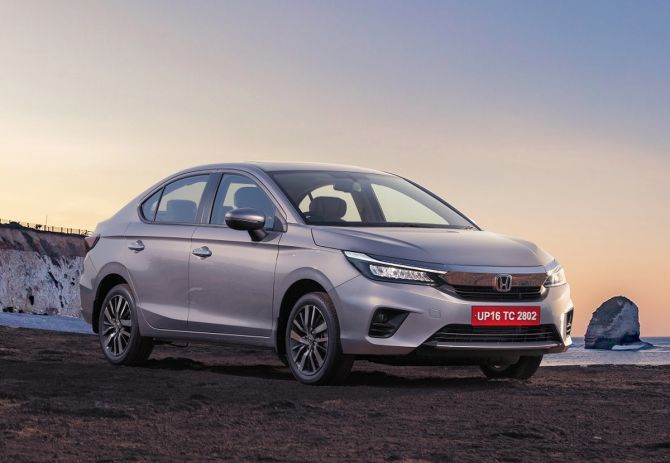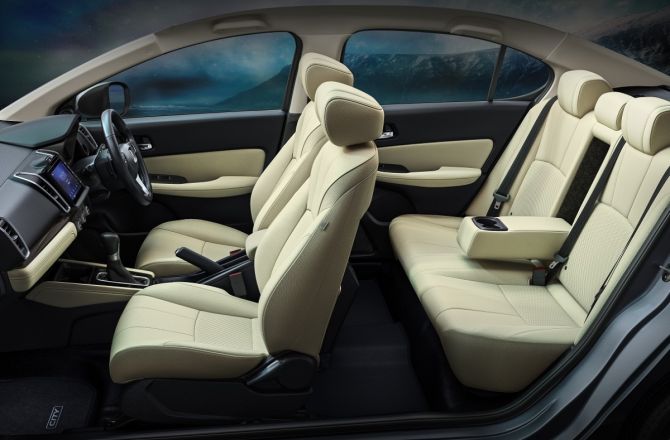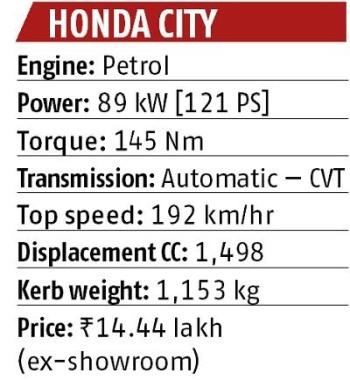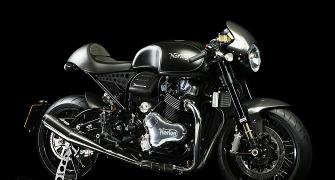When a manufacturer launches the fifth generation of a product, it is given that earlier avatars hit the mark.
Ditto for the new Honda City, the latest version of which also brings in sweeping changes to the carmaker's product strategy for the Indian market, says Pavan Lall.

The very first car I bought, when in college in Texas, was a champagne-coloured, second-hand, 1990 two-door coupe Honda Accord.
It had bucket seats, automatic safety belts and a sports button that gave you extra speed when needed. As an 18-year old, every time I stepped into that car, I smiled.
The 2020 Honda City sedan brought that smile back.
When a manufacturer launches the fifth generation of a product, it is given that earlier avatars hit the mark.
Ditto for the new Honda City, the latest version of which also brings in sweeping changes to the carmaker's product strategy for the Indian market.
It comes at a time when diehard Honda fans of yesteryear had begun to wonder why obvious features such as higher tensile steel, automatic transmission and sufficient ground clearance hadn't been introduced.
The latest Honda City is not just a cosmetic upgrade, but very much a brand new car.

From the freshly sculpted chrome wing on the front grill and the shark fin on the roof, which lends it the air of a car of a higher class, to the longer and wider body carriage, the new City looks nothing like its predecessors. Neither from the outside nor the inside.
The dashboard is singularly impressive with trims in wood and leather and a touch-activated infotainment screen, which has raised the bar for all cars under Rs 15 lakh (ex-showroom).
The side-view mirrors unfold automatically, and the automatic petrol variant, which I am testing, also comes with remote engine start, remote controlled window and sunroof as well as auto functions for headlamps.
While competitor Hyundai Verna too has some of these features, the Maruti Ciaz, the other sedan in this segment, doesn't.

There's also the lane-change camera view that comes on as you switch lanes, letting you see what's going on around you. This is a first for a car in this price range. But the one thing I missed was motorised seat adjusters. That would be welcome in future models.
Many Honda cars are considered to be overpriced. The Jazz cost between Rs 7.10 lakh and Rs 7.60 lakh -- too expensive for a hatchback, even if it was built on the City platform.
Most hatchbacks then were in the Rs 5-6 lakh band. The new City sedan, which costs between Rs 11 lakh and Rs 15 lakh, pays heed to price.

Coming to the driving experience. Earlier models had ground clearance issues on city streets. Getting over speed bumps was a grating experience, given the scrapes that would impact the undercarriage, not to mention the damage to the mud flaps.
This problem has been fixed with a new suspension that allows you to cruise over medium-sized breakers with ease. I even went over a speed bump at a higher than advisable speed but felt nothing.
Initially, the automatic petrol felt a wee bit sluggish and the six-speed CVT (continuously variable transmission) took some getting used to. But the car slips into a comfortable ride mode soon enough, with adequate speed and torque for in-city usage.
Still, if you feel the need for more punch, just hit the S button (which is for sportier driving and harkens back to the Accord I once owned).
The earlier versions would have the same soft, pliant ride quality, except that one was aware of travelling in a light-weight car.
Not so with the new City, which is at least 50 kilos heavier, and feels stronger, safer and more secure.
However, push the car hard over the corners and you might experience a little instability. But then if sporty street driving is what you're looking for, get a BMW M3.
What the new City promises to deliver is great ride quality, lots of features and the trademark Honda reliability.
The Japanese carmaker even offers an add-on, decade-long warranty. If that's not a sign of confidence in its capabilities, what is?
Feature Presentation: Rajesh Alva/Rediff.com










